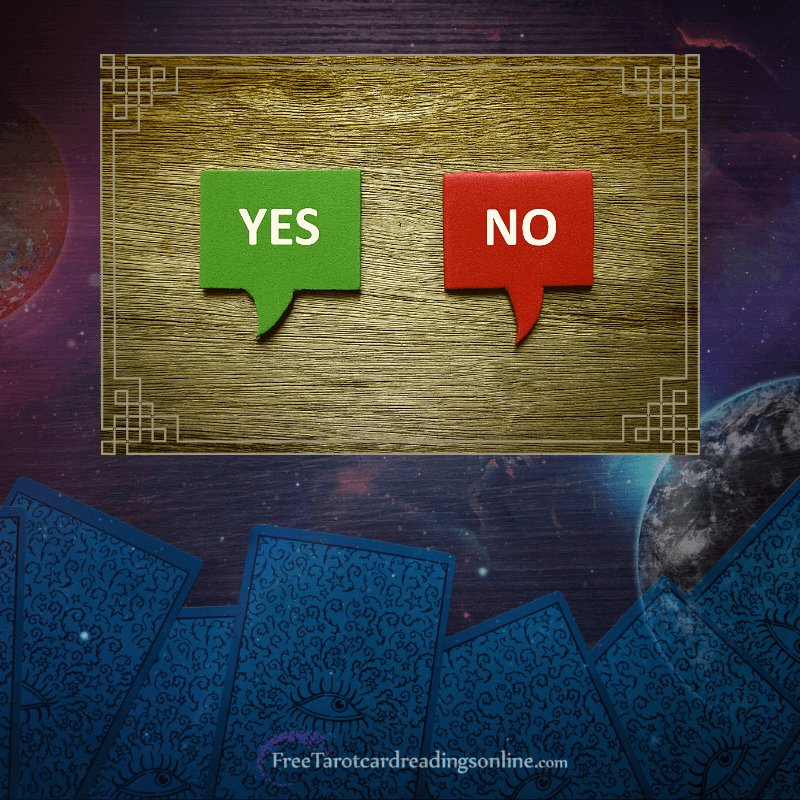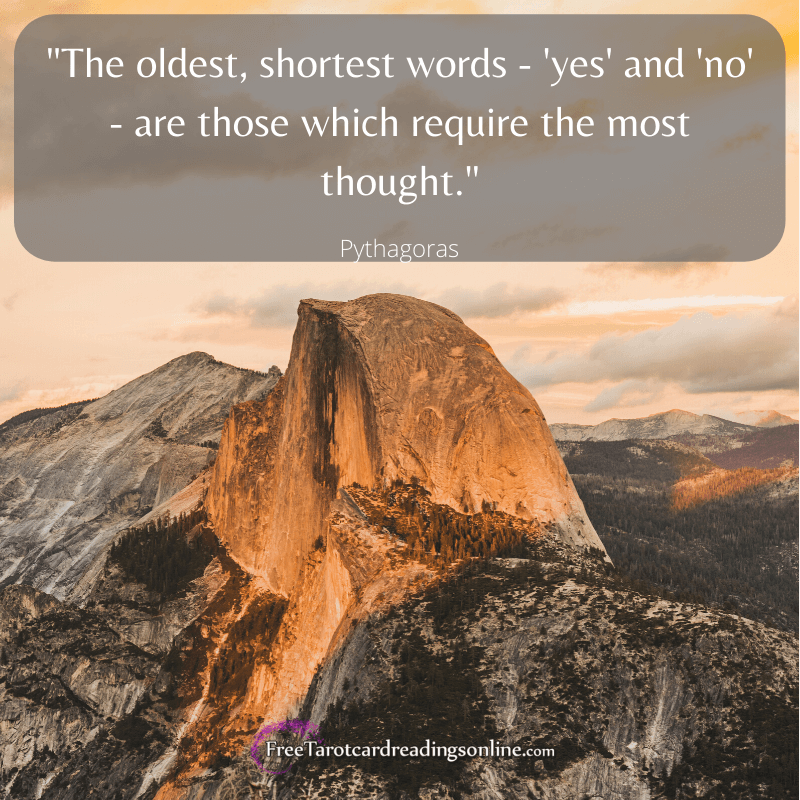
Ultimate Guide to Yes or No Questions in Tarot Readings
Yes or No questions might seem against the rules in tarot readings. But with the right guidelines, you can ask these types of questions and still have a powerful reading. Discover how to ask yes or no questions in tarot so you feel more confident and connected.
Should We Ask Yes Or No Questions In Tarot?
Some might argue that yes or no questions don’t really jive well with tarot. Tarot allows you to go beyond the conscious mind and discover energies and influences that can impact your current and future experiences.
So, one potential argument against yes or no questions is that they can prevent us from accessing deeper insight, or the rich symbolism within tarot.
Another argument is that yes or no questions feel both rigid and inflexible. And if we’re not careful, they can keep us from exercising our free will and lock us into a future where you’re not an active participant.
When it comes to yes or no questions, there’s definitely a potential for these limitations. But with the right approach, you can still have a rich and inspiring reading with yes or no questions. These nine guidelines show you how.
1. How To Ask Yes Or No Questions With Upright Or Reversed Cards
Reading upright or reversed cards is the most basic way to ask yes or no questions. The rule is simply this: if you draw an upright card, the answer is yes; if you have a reversed card, the answer is no.
An important tip here is to have a balanced deck with an equal amount of upright and reversed cards before the reading begins. The easiest way to do this is to divide your deck, flip one half of the deck, and then reshuffle the cards. You can do this a couple of times so you have a balanced deck for your reading.
This is the simplest way to ask yes or no questions in tarot. It’s important to remember that you will forfeit a deeper and potentially richer tarot reading in exchange for simple, yes-no reading.
But at the same time, it’s good to remember that the Universe and our intuition often do not need elaborate sentences to convey their message. Simple yes or no answers can do the trick, too.
2. Assign Every Card To Yes Or No Categories
Before you start your reading, take a moment, and consider each card, one by one. If a card feels intuitively like a “Yes” card, place that in your “Yes” stack. Continue to go through the entire deck, and sort your cards by “Yes”, “No” and “Maybe.” There’s no rulebook here. Yes, cards have a traditional meaning, but this is also an opportunity to sit quietly with your intuition and with each card. It’s a chance to feel your own unique connection with them.
You might want to create a list of your “Yes”, “No” and “Maybe” cards before the reading starts so you have an easy reference point. Making these distinctions before the reading also helps you flow through a reading without being tempted to switch a card’s meaning if the answer is unexpected or unwelcome.
3. Replace “Yes” And “No” With Softer Alternatives
Yes or No are pretty definitive answers, aren’t they? They don’t really leave much room for interpretation, and they can also hold people back from taking steps or making decisions that might feel correct or in alignment. This isn’t the result you want with a tarot reading.
So, how can you use yes or no questions, AND leave room for free will, individual sovereignty, and intuition? Try softening yes or no questions with something more flexible.
For example, instead of saying a hard yes or no, you can say that something is more favorable or unfavorable; that something is more likely or less likely; or that an outcome has a greater or lesser potential. These are all ways to do yes or no readings that still leaves room for personal action steps.
4. Offer Conditional Yes And No Answers
Have you ever made plans that are contingent on other things? For example, on Sunday, you and your friends want to go hiking in the park IF the weather is good. Or, you’ll bake some brownies IF you can find all the ingredients?
These are all conditional “Yes” situations. Yes, you’ll go hiking IF x happens. Yes, you’ll bake something yummy IF you can find x. You can apply the same approach to tarot.
For example, if you ask a yes or no question, “Will I be successful in my new position at work” and you draw the Emperor, the answer may be: Yes, if you are comfortable stepping into a leadership role and integrating a well-organized system with rules and guidelines for your team.
5. Use The Card’s Straightforward Meaning
This fifth and final guideline is ideal if you have a good understanding of the cards’ traditional meanings and feel comfortable interpreting each card as it comes up.
For example, if you (or your client) want to know if you will find a new job in the coming year, and you draw an Ace of Pentacles, the answer is probably yes. Why? Because the Ace of Pentacles focuses on new opportunities, especially those involving career, wealth, and business.
6. Ask Questions That Allow For Positive Outcomes
When we’re scared or worried about something, we may ask negatively biased questions. For example, “Am I going to lose my job and be poor?” Or, “Am I going to have to leave my partner and never find love again?”
When we start to hear questions like this, it’s time to check-in and ask: Is that the question you really want to be asking? Would it be better to reframe this fear or worry into something that supports you for the better?
For example, instead of asking if you’ll have to leave your partner and go without love, you could ask tarot, “Can I find ways to experience the love I need in my life?” You see, by doing this, you shift out of scarcity, fear-based mindset, and open the possibilities because you’ve switched over to an abundant and affluent mindset.
7. Ask One Question At A Time
Sometimes, we ask more than one question at once. Be sure to avoid this with yes or no tarot readings. That way, you’re more likely to hear a clear yes or no answer and have more clarity, rather than adding confusion and uncertainty to the situation.
8. Commit To Yes Or No Questions
Yes or no questions may give you answers you may or may not like. And you may be tempted to switch out of the yes or no model mid-reading. Try to remain committed to the original approach. And remember: tarot is powerful and will answer you. So, only ask questions that you want an answer to.
9. Learn To Be Comfortable With Uncomfortable Answers
Tarot can be like tough love. It’s a portal into your subconscious mind, and it’s also an opportunity to tune into your intuition and uncover truths and beliefs you don’t always interact with. As a result, tarot isn’t censored or worried whether you’ll like the answer or not.
If you’re doing yes or no tarot readings, you may be tempted to draw another card, and then another if you’re uncomfortable or dissatisfied with the first answer you get. But try to avoid this. Try to sit with the answers you receive even if they shine a light on something that’s used to staying in the dark. Check-in: why do they make you uncomfortable? The answers may help you heal, grow, and expand.
Yes or no tarot readings can be limiting and hedge us in. Or, they can be incredibly expansive experiences that guide you deep into your intuitive self – all with simple yes or no answers. The next time you want to practice tarot, use these nine guidelines to ask yes or no questions with greater confidence and trust.

